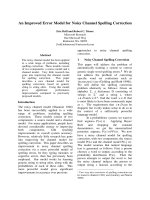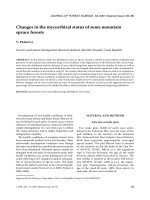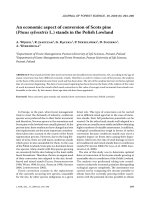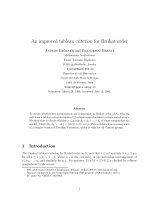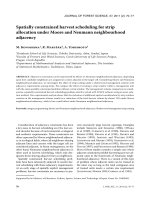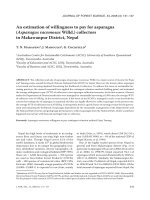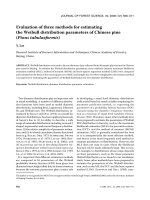Báo cáo lâm nghiệp: "An improved micropropagation protocol for stone pine (Pinus pinea L.)" potx
Bạn đang xem bản rút gọn của tài liệu. Xem và tải ngay bản đầy đủ của tài liệu tại đây (412.42 KB, 7 trang )
Ann. For. Sci. 63 (2006) 879–885 879
c
INRA, EDP Sciences, 2006
DOI: 10.1051/forest:2006071
Original article
An improved micropropagation protocol for stone pine
(Pinus pinea L.)
Pablo A
a
,PalomaM
´
b
, Belén F
´
a
,AnaR
´
a
,MariaLuzC
c
,
Ricardo J. O
´
a
*
a
Área de Fisiología Vegetal, Instituto Universitario de Biotecnología, Departamento de Biología de Organismos y Sistemas, Universidad de Oviedo,
C/ Catedrático Rodrigo Uría s/n, 330071 Oviedo, Spain
b
Current adress: Instituto Vasco de Investigación y Desarrollo Agrario, Centro Arkaute, Aptdo. 46, 01080 Vitoria-Gasteiz, País Vasco, Spain
c
Departamento de Biología Vegetal, Universidad de León, Facultad de Ciencias Biológicas y Ambientales, Campus de Vegazana, León, Spain
(Received 9 November 2005; accepted 30 May 2006)
Abstract – A protocol for micropropagation from isolated cotyledons from Pinus pinea L. has been developed. Major improvements are the increase
in rooting rates and the description for the first time of a successful continuous multiplication procedure. For bud induction, isolated cotyledons were
cultured on
1
/
2
LP with 44.4 µM BA during 4 days. Shoot development was obtained by transfer to
1
/
2
LP hormone-free medium with activated charcoal.
Since an additional 20 weeks were required for shoot elongation and rooting, at least 70 plantlets can be expected per seed after 29 weeks based on a
70% success rate. Besides, shoots can be micropropagated successively by subculturing on
1
/
2
LPC.
conifers / micropropagation / organogenesis / rooting / tissue culture
Résumé – Amélioration du protocole de multiplication par micropr opagation du pin pignon (Pinus pinea L.). Nous avons développé un protocole
de multiplication par micropropagation de Pinus pinea L. à partir de cotylédons isolés. Les principaux progrès réalisés concernent l’augmentation du
taux d’enracinement et la description pour la première fois d’une méthode de multiplication en continu. Pour l’induction des bourgeons, des cotylédons
isolés ont été cultivés dans le milieu
1
/
2
LP avec 44.4 µM BA pendant 4 jours. Le développement des pousses a été obtenu en transférant les bourgeons
dans un milieu
1
/
2
LP sans hormone avec du charbon actif. Compte tenu des délais nécessaires (20 semaines) pour obtenir l’élongation des pousses et
l’enracinement, au moins 70 plantules par graine peuvent être obtenues au bout de 29 semaines, sur base d’un taux d’enracinement de 70 %. De plus,
les pousses peuvent être multipliées avec succès par micropropagation par sous-culture dans le milieu
1
/
2
LPC.
conifère / micropropagation / organogenèse / enracinement / culture de tissus
1. INTRODUCTION
Stone pine (Pinus pinea L.) is an economically important
tree in the Mediterranean area, with an important role in soil
conservation, landscape architecture, and is highly regarded
for its edible seeds. This makes many aspects of its manage-
ment similar to an agronomic tree. The existence of a wide
potential for improvement and the great economic value of
the pine nuts gives good reasons for genetic breeding pro-
grams. These programs are based on the identification of ex-
cellent genotypes by establishing clonal banks with differ-
ent provenances. The heritability of seed characters such as
length, number per cone and cone weight is high [14]. Hence
an improvement in the quantity and quality of seed produc-
tion per tree is one of the main objectives of the developing
programmes in this area. Unfortunately the stone pine prun-
ing possibilities are very limited, as this species does not root
as cutting (Luis Gil, personal communication). Grafting is the
preferred method to propagate and evaluate genetically indi-
* Corresponding author: rordas@.uniovi.es
vidual clones. The conventional techniques of asexual propa-
gation present problems for obtaining the best results. In ad-
dition, an identical clone implanted on different rootstocks
presents an interaction scion-rootstock that leads to certain
variability in the results and different productivities (Luis Gil,
personal communication). This problem implies finding not
only the best scion, but also, the most appropriate rootstock.
The limitations of this optimal rootstock present the inconve-
nience in propagation of certain genotypes already in mature
state. Recently, the development of a micrografting protocol
could improve the current situation of P. pinea breeding pro-
grams by reducing its costs and allowing a rapid build-up of
plantations for genotype selection trials [5].
In vitro culture offers the possibility to propagate Pinus
pinea L. on a large scale, which is difficult by other tradi-
tional procedures such as rooting from selected pines. The
production of clonal plants from selected seeds of this conif-
erous species via organogenesis has been thoroughly stud-
ied [4, 6, 7, 14, 18]. The propagation system is based on the
induction of shoot buds in cotyledonary explants dissected
from stone pine embryos and cultured in the presence of a
Article published by EDP Sciences and available at or />880 P. Alonso et al.
cytokinin (Ck), usually N
6
-benzyladenine (BA). On the con-
trary to what has been reported for other pines [9], the pres-
ence of auxins in the caulogenic induction media does not im-
prove the efficiency of the organogenic response in stone pine
cotyledons [18]. Adventitious bud formation is direct and de-
pendent on the exposure time and concentration of BA in the
medium [13]. Age and tissue differentiation of P. pinea ex-
plants are other determining factors, as shown by the inverse
relationship between germination time of the embryos and the
shoot-forming ability of their excised cotyledons [19]. Nev-
ertheless, various aspects of the system could be improved,
among which a reduction in bud induction period would be
particularly beneficial [13]. Moreover, the continuous mul-
tiplication had not been established and the rooting process
required additional experimentation. Although clonal propa-
gation of stone pine via adventitious bud stimulation from
cotyledons was obtained, the very low efficiency of the root-
ing process [4, 7, 18] remained the bottleneck of stone pine
micropropagation, reducing the possibilities of applying this
technique on a usable scale. In this paper, we present an im-
proved plant regeneration method of P. pinea that reduces the
bud induction time, dramatically increases the rooting rate and
for the first time shows a successfully proliferation procedure.
2. MATERIAL AND METHODS
2.1. Explant source and culture conditions
Embryos from 1-year-old stone pine (Pinus pinea L.) seeds were
used. Seeds obtained from selected open-pollinated trees in natural
stands were provided by the Servicio de Material Genético of the
Ministerio de Medio Ambiente (Spain). All through the experimen-
tation, lots of seeds belonging to 2000, 2001 and 2002 years from
Meseta Norte (ES01 region) were used.
After removal of the seed coat, megagametophytes were surface
sterilized by immersion in 7.5% H
2
O
2
for 45 min, followed by three
rinses in sterile double-distilled water. Megagametophytes were then
imbibed in moistened sterile paper for 48 h at 4
◦
C in darkness to
facilitate dissection of the embryos.
Plant cultures were maintained in a growth chamber at 25 ±
1
◦
C with a 16-h photoperiod under a photosynthetic photon flux
of 80 ± 5 µmol m
−2
s
−1
provided by cool white fluorescent tubes
(TLD 58 W/33, Philips, France), except where indicated.
2.2. Bud induction and growth
After the above mentioned imbibition period, cotyledons (an av-
erage of 10 per seed, Fig. 2A) were excised from embryos and
horizontally placed in baby jars (ten per jar) containing 20 mL
of bud induction medium, consisting of Le Poivre medium with
half strength macroelements (
1
/
2
LP), as modified by Aitken-Christie
et al. [1], supplemented with 0.8% (w/v) agar (Roko S.A., A Coruña,
Spain), 3% (w/v) sucrose and cytokinins. The cytokinins assayed
were BA, N
6
-benzyladenosine (9R-BA), N
6
-isopentenyladenine (iP),
N
6
-isopentenyladenosine (iPR), meta-Topolin (mT), Zeatin (Z) and
Zeatin riboside (ZR) at different concentrations (0.4, 1, 4.4, 10 or
44.4 µM). After 35 d on bud induction medium, the cotyledons
were transferred to a hormone free medium (
1
/
2
LPC) consisting
of
1
/
2
LP supplemented with 0.5% (w/v) activated charcoal (AC)
(Sigma, Madrid, Spain), 0.8% (w/v) agar and 3% (w/v) sucrose ac-
cording to Humara et al. [8]. Before autoclaving, the pH of all me-
dia was adjusted to 5.8. The explants were subcultured monthly onto
the same fresh bud growth medium (
1
/
2
LPC). After two subcul-
tures (60 d) on
1
/
2
LPC, the percentage of cotyledons forming buds
(CFB), number of buds per cotyledons, bud forming capacity index
(BFC = [% cotyledons forming buds × average number buds per
cotyledon]/100) and the shoot elongation capacity (SEC = [number
shoots > 10 mm/total number shoots per explant] × 100) were calcu-
lated for all bud induction treatments according to Lopez et al. [9].
2.3. Shoot development and axillary bud multiplication
For bud induction, the cotyledons were induced in bud induction
medium consisting on
1
/
2
LP with 44.4 µM BA according to Mon-
caleán et al. [13]. The influence of BA exposure time (2, 4, 8, 16 and
35 d) of cotyledons (named C2, C4, C8, C16 and C35) was studied.
After two monthly subcultures on
1
/
2
LPC medium for shoot devel-
opment from induced buds, the shoots (named S2, S4 and S8 from
C2, C4 and C8 cotyledons) were separated from the cotyledonary
explants and elongated by sequential subculturing on shoot growth
medium in baby jars for 15 d followed by subculture to
1
/
2
LPC for
30 d. Shoot growth media tested were
1
/
2
LPC or a
1
/
2
LP containing
BA (4.4; 0.4 or 0.04 µM) alone or 4.4 µM BA with indol-butyric acid
(IBA), (0.4, 0.04 or 0.004 µM). At the end of two elongation peri-
ods (90 d) the cotyledon survival percentage, SEC and multiplication
rate (number of shoot at the end of subculture/ initial shoots explants)
were determined.
2.4. Rooting shoots and acclimatization of plants
For rooting, elongated microshoots (> 10 mm) grown on
1
/
2
LPC
were transferred to culture tubes with rooting medium LP supple-
mented with 10 µM naphtalen acetic acid (NAA), 20 g L
−1
glucose
and 0.8% (w/v) of Roko-Agar according to Amely Zavattieri (per-
sonal communication). This induction phase of adventitious root for-
mation took place one week in the dark at 19
◦
C and another one
with 16-h photoperiod under a photosynthetic photon flux of 100 ±
5 µmol m
−2
s
−1
at the same temperature. After 2 wk, treated shoots
were transferred to expression media LP with 10 g L
−1
glucose but
without regulators and were maintained in a growth chamber at 21 ±
1
◦
C with the mentioned light conditions. Various macroelements
strengths (1,
1
/
2
or
1
/
4
) in rooting and expression media were assayed.
The percentage of survival, rooted shoots and the number of roots per
shoot were recorded after 45 d on expression media.
After six weeks of culturing on expression medium, rooted shoots
with 10 mm or longer roots were transferred to a sterile peat- perlite
1:4 (v/v) mixture and grown under high relative humidity (95%) in
a green house. After about 2 wk, the plants could be transferred to
normal humidity conditions.
2.5. Data analysis
A completely randomized experimental design was applied and
experiments were repeated at least three times. At least 30 explants
Micropropagation protocol for stone pine 881
Table I. Effect of different exposure time to BA 44.4 µM on survival, percentage of cotyledons forming buds (CBF), buds per cotyledon and
bud forming capacity (BFC) in Pinus pinea L. Isolated cotyledons were cultured
1
/
2
LP with 44.4 µM BA and transferred to the same medium
without growth regulators and activated charcoal (
1
/
2
LPC). Data was taken after 60 days on
1
/
2
LPC. Values are means ± SE (n ≥ 30). Significant
differences (α = 0.05) between incubation period are indicated by different letters.
Induction period (d) Survival (%) CFB (%) Buds per cotyledon
1
BFC
35 100 a 100 a 33.12 ± 1.23 a 33.12 a
16 100 a 96.66 a 29.06 ± 0.95 a 28.08 a
8 90.63 b 90.85 a 10.58 ± 0.26 b 9.61 b
4 80.32 b 90.05 a 6.82 ± 0.23 c 6.14b
2 44.55 c 45.49 b 3.49 ± 0.19 d 1.58 c
0 18.79 d 0 c 0 e 0 d
1
Excludes cotyledons without buds.
(cotyledons or shoots) per treatment were used. Data are presented
as mean ± standard error (SE). The statistical analysis of frequen-
cies (e.g. % cotyledons forming buds) were usually carried out with
the χ
2
test, except where indicated. Quantitative data (e.g. number
of buds per cotyledon) were analyzed by non parametric tests. The
Kruskall-Wallis test for n independent group analyses was used, and
the Mann-Whitney test for two independent group analyses. Differ-
ences were considered significant at the 5% level. All statistical tests
were performed with STATISTICA
software.
3. RESULTS AND DISCUSSION
3.1. Bud induction
In order to study the correlation between cytokinin types
and quantitative aspects of development, different cytokinins
and concentrations were studied (Fig. 1). After 35 d of culture
on bud induction medium, cotyledons were subcultured two
times on growth-regulator free medium with activated char-
coal (
1
/
2
LPC) for bud growth. The induction of adventitious
shoots on the cotyledons required the presence of cytokinin in
the culture medium. Except for iPR and RZ, the other assayed
cytokinins induced bud formation in cotyledons. The highest
percentage (100%) of cotyledons forming buds and the high-
est mean number of buds per cotyledon (data not shown) were
obtained in BA treated cotyledons. The minimum concentra-
tion of assayed cytokinins (0.4 µM) necessary to induce buds
(CFB) was observed for BA and 9R-BA. Using m-T no mor-
phogenic response was obtained at the low concentrations (0.4
and 1 µM) and it was necessary to apply ≥ 4.4 µMinorder
to obtain bud induction. Both in iP and Z -treated cotyledons
10 µM and higher were needed to obtain a response.
BA and its riboside were the most efficient of the cytokinins
assayed. In stone pine cotyledons, the effect of BA concen-
tration and length of exposure on bud induction was already
analysed by our group [12,13,19] but the influence of these in
the later shoot development was not studied previously. Bud
induction was obtained when
1
/
2
LP with 44.4 µM BA was ap-
plied during various induction periods and consequently, this
media was used as the bud induction medium (Tab. I). Sig-
nificant differences in the CFB, BFC, survival percentage and
Figure 1. Percentage of cotyledons forming buds (CFB) in Pinus
pinea L. Cotyledons were cultured in vitro on
1
/
2
LP medium with dif-
ferent cytokinins for 35 d and then transferred to
1
/
2
LPC. Data were
taken after 60 days of culture. Percentages have been transformed us-
ing arcsin transformation for statistical analysis. Two way analysis
of variance (ANOVA) with type of Ck and concentration as the two
factors tested, indicated that both were significant at p ≤ 0.05 for
percentage of cotyledons forming buds.
number of buds per cotyledon were observed depending on
the BA-exposure time (2, 4, 8, 16 or 35 d) (Tab. I). A two-day
treatment showed very low percentage of survival (44.55%),
CFB and buds per cotyledons (3.49 ± 0.19). Exposing cotyle-
dons to BA for 4, 8, 16 or 35 d increased significantly the CFB.
Explants cultured 35 d or 16 d in presence of BA showed the
highest CFB (> 95%), but callus formation was also observed.
When the induction period was reduced to 8 or 4 d, CFB was
not affected but a significantly decrease in the number of buds
was observed. Among the exposure times examined, shoot de-
velopment at the end of two subcultures on
1
/
2
LPC was the
greatest when the cotyledons were exposed to BA for 4 or 8 d.
Explants cultured 35 or 16 d in presence of BA showed the
formation of nodular primordia on the entire surface of cotyle-
dons in contact with the medium, although shoot organogen-
esis was higher on the basal segment of the cotyledons for
all treatments. However, few of these primordia developed
into buds and shoots after transferring to
1
/
2
LPC. This was
882 P. Alonso et al.
Figure 2. Adventitious shoot formation of Pinus pinea L. excised cotyledons. (A) Excised cotyledons from 0 d germinated embryos. (B) Ad-
ventitious buds in 4 d BA treated cotyledons after 35 d of culture. (C) Axillary shoots after 4 subcultures in
1
/
2
LPC. (D) Rooted shoots excised
from (C) after 4 wk in expression media. (E) A 1-year-old plantlet grown under greenhouse conditions. (A color version of this Figure is
available at www.edpsciences.org/forest.)
presumably due to the proximity and competition among pri-
mordia. Buds were located along entire length of 4 and 8 d
treated cotyledons (Fig. 2B). The lowest exposure time (2 d)
caused a redistribution of induced buds to the basal zone. Our
data support the observations of Valdés et al. [19] and Sul and
Korban [18]. Valdés et al. [19] suggested that a decrease of en-
dogenous cytokinins levels may be involved in loss of shoot-
forming ability in the apical portions of stone pine cotyledons.
On the contrary, other studies in pines such as P. nigra [9]
or P. ayacahuite [16], described the apical area of cotyledons
as more organogenic. In general, like in other pines [9, 16],
adventitious bud induction on excised cotyledons from stone
pine ungerminated embryos was strongly influenced by the
length of the exposure to growth regulators.
Although the number of buds formed in each cotyledon
was lower in explants incubated for 4 or 8 d in 44.4 µMBA
than in explants cultured for 16 and 35 d, the minimum induc-
tion period to obtain an optimal percentage, number of shoots
Micropropagation protocol for stone pine 883
Table II. Effect of different hormonal treatments on multiplication rate, shoot elongation capacity (SEC) and survival on S4 shoots of Pinus
pinea L. The isolated shoots were successively subcultured on
1
/
2
LP with active charcoal (
1
/
2
LPC) or BA and AIB for 15 d and then transferred
to
1
/
2
LPC for 30 d. Values correspond with two subcultures and are means ± SE (n ≥ 120). Significant differences (α = 0.05) between hormonal
treatments are indicated by different letters.
Hormonal treatment First subculture (45d) Second subculture (90 d)
Survival(%) Multiplication rate SEC Multiplication rate SEC
1
/
2
LPC 91.6 a 2.6 ± 0.35 a 25.64 a 2.0 ± 0.11 a 81.48 a
BA (µM) AIB (µM)
4.4 0 97.2 a 2.6 ± 0.51 a 12.57 a 1.8 ± 0.21 a 40.54 b
0.4 0 97.2 a 2.1 ± 0.15 a 19.48 a 1.4 ± 0.14 a 38.00 b
0.04 0 97.2 a 2.2 ± 0.12 a 24.19 a 1.7 ± 0.09 a 40.38 b
4.4 0.004 94.44 a 2.4 ± 0.13 a 17.97 a 1.5 ± 0.11 a 67.07 c
4.4 0.04 94.44 a 2.3 ± 0.14 a 14.61 a 1.8 ± 0.25 a 37.31 b
4.4 0.4 97.2 a 2.6 ± 0.23 a 26.75 a 1.6 ± 0.20 a 71.42 c
per cotyledon and highest survival index was 4 or 8 d. These
shorter periods are preferred because not only do they reduce
the induction culture period, but also avoid callus formation
and development of hyperhydric shoots, as was also observed
in P. nigra [9] and P. ayacahuite [16]. In addition, a short bud
induction period could lead to a higher rooting capacity as a
result of a minor BA inhibitory influence in the rooting pro-
cess. Following this protocol, an average of 100 shoots can be
obtained per seed after 9 wk in culture.
3.2. Shoot development and axillary bud multiplication
The multiplication phase, carried out with shoots separated
from the cotyledonary explants and elongated by sequential
subculturing on shoot growth medium, led to production of
axillary shoots which were excised and subcultured. Shoot ex-
plants (S2) from C2 cotyledons showed the lowest survival
percentage (48.32%), multiplication rate (1.4 ± 0.065) and
SEC (9.52) after 45 d on
1
/
2
LPC and were discarded. After
two subculture cycles (90 d), the survival percentage and mul-
tiplication rate were not significantly different between S4 and
S8 shoots. On the contrary the SEC increase significantly in
the second subculture of S4 shoots.
When BA and IBA were applied in shoot growth medium
(Tab. II), the elongation index (SEC) was significantly lower
than on
1
/
2
LPC (81.5) and the multiplication rate was not sig-
nificantly increased (2.0 ± 0.11). García-Ferriz et al. [6] de-
scribes this behaviour in P. pinea shoots when BA is applied
in shoot development and multiplication stages, besides re-
porting the appearance of hyperhydric shoots. However, they
did not observe any significant increase in the SEC index
when shoots are cultured with activated charcoal. In our as-
say, although it could be influenced by the short BA induction
period applied, the use of activated charcoal increases shoot
development significantly during the elongation and multipli-
cation stages (Tab. II). In fact, shoot elongation and multipli-
cation rates were accelerated by subculturing successively on
1
/
2
LPC medium. An average of 4.64 ± 0.85axillary shoots and
a 97.4 percentage of shoots higher than 10 mm were obtained
after 4 subcultures (26 wk) on
1
/
2
LPC (Fig. 2C). In addition,
plagiotropic growth was never observed.
The development of nodular tissue (formed during bud in-
duction) into shoots with primary needles was promoted by
transferring cotyledonary explants to hormone free medium,
as described previously for other pines such as P. canarien-
sis [10]. Although its mechanism of action remains unclear,
the cytokinin adsorption capacity of activated charcoal is well
known, besides adsorbing other compounds like polyphenols,
inorganic cations (Cu
+
,Zn
+
) or 5-hydroxymethyl furfural (in-
hibitory compound released from sucrose autoclaving) that in-
hibit shoot development[20,21], and specifically P. pinea root-
ing [2].
3.3. Rooting shoots
The data showed that the macro-salts dilutions both in in-
duction and expression phase affected significantly the rhi-
zogenic efficiency (Tab. III). Up to 68% of ryzogenesis was
achieved when shoots were cultured on
1
/
2
LP during root in-
duction and expression. Roots appeared after 3−6 wk under
these conditions (Fig. 2D). In all treatments, the roots obtained
(1−3) were morphological normal. These data greatly improve
the rhizogenesis efficiency, when compared to Capuana and
Giannini [4], Gonzalez et al. [7] and Sul and Korban [18]
which showed low levels (35, 15 and 15%, respectively).
Because an additional 20 wk were required for shoot elon-
gation and rooting, based on a 70% rooting success rate, at
least 70 plantlets can be expected per seed after 29 wk. Be-
sides, shoots can be micropropagated successively by subcul-
turing on
1
/
2
LPC.
Low levels of macronutrients in medium are beneficial for
root formation in many plants. In general, it has been reported
that the reduction of salts, particularly nitrogen, in the cul-
ture media seems to favour the adventitious rooting of cut-
tings [11, 15]. Sriskandarajah et al. [17] reports that a reduc-
tion on the level of NH
4
NO
3
in the MS culture media from
884 P. Alonso et al.
Table III. Effect of the dilutions of macroelements on LP culture medium during the induction and expression rooting phases of Pinus pinea L.
microshoots. Values are means ± SE (n ≥ 30). Significant differences (α = 0.05) between dilutions are indicated by different letters.
LP Macronutrients dilution
Rooting % Number of roots/microshoot
1
Induction Expression
1 1 36.12a 1.7
1
1
/
2
47.09b 2.2
1
1
/
4
56.38c 1.6
1
/
2
1 64.80d 1.9
1
/
2
1
/
2
68.33d 2.8
1
/
2
1
/
4
38.12a 2.5
1
/
4
1 31.78e 2.5
1
/
4
1
/
2
27.56e 2.1
1
/
4
1
/
4
41.77a 1.9
1
Excludes shoots without roots.
full strength to
1
/
4
strength significantly increases the percent-
age rooting in several scion apple cultivars. Our results point
that way but we obtain less rooting when the macronutrients
strength was
1
/
4
. This phenomenon could be explained because
LP levels of nitrogen are much lower than those present in MS
and dilutions higher than
1
/
2
would represent very low levels
of nitrogen for P. pinea shoots to be rooted. In general, we
showed that the macrosalts strength of culture medium affect
significantly the rooting efficiency of stone pine microshoots
and must be optimized.
For acclimatization experiments at least 100 microplants
were transferred to a sterile peat-perlite (1:4 v/v) mixture and
grown under decreasing initially high relative humidity allow-
ing its transfer to normal conditions two weeks later. Survival
of microplants after two months in the nursery reached 98%.
No plagiotropic growth was observed and the plants showed a
well developed root system capable of sustaining further shoot
outgrowth (Fig. 2E). Our level of acclimatization is markedly
higher than the only previous data reported by Capuana and
Giannini [4] which showed a discrete level of survival (60%).
The protocol presented here allows and greatly improves
the method for plant regeneration in stone pine, when com-
pared to Capuana and Giannini [4] Gonzalez et al. [7] and Sul
and Korban [18]. This protocol is being applied successfully
to produce and provide stone pine clonal plants obtained from
selected seeds to the Programa de Mejora Genética del pino
piñonero de Castilla y León (Spain).
Acknowledgements: The authors sincerely thank Jaime Menéndez
Humara for the revising of the English language. Pablo Alonso and
this work were supported by Ministerio de Ciencia y Tecnología de
España (MCT-02-AGL-00867).
REFERENCES
[1] Aitken-Christie J., Singh A.P., Horgan K.J., Thorpe T., Explant de-
velopmental state and shoot formation in Pinus radiata cotyledons,
Bot. Gaz. 146 (1985) 190−203.
[2] Arduini I., Godbold D.L., Onnis A., Influence of copper on root
growth and morphology of Pinus pinea L. and Pinus pinaster Ait.
Seedlings, Tree Physiol. 15 (1995) 411−415.
[3] Auer C.A., Motyka V., Brezinová A., Kamínek M., Endogenous cy-
tokinin accumulation and cytokinin oxidase activity during shoot
organogenesis of Petunia hybrida, Physiol. Plant. 105 (1999)
141−147.
[4] Capuana M., Giannini R., In vitro plantlets regeneration from em-
bryonic explants of Pinus pinea L., In Vitro Cell Dev. Biol. Plant 31
(1995) 202−206.
[5] Cortizo M., Alonso P., Fernández B., Rodríguez A., Centeno M.L.,
Ordás R.J., Micrografting of mature stone pine (Pinus pinea L.)
trees, Ann. For. Sci. 61 (2004) 843−845.
[6] García-Ferriz L., Serrano L., Pardos J.A., In vitro shoot organogene-
sis from excised immature cotyledons and microcuttings production
in stone pine, Plant Cell Tissue Organ Cult. 36 (1994) 135−140.
[7] Gonzalez M.V., Rey M., Tavazza R., La Malfa S., Cuozzo L.,
Ancora G., Improvement of in vitro adventitious shoot formation
on cotyledons of Pinus pinea L., HortScience 33 (1998) 749−750.
[8] Humara J.M., Lopez M., Ordás R.J., Agrobacterium tumefaciens-
mediated transformation of Pinus pinea L. cotyledons: an assess-
ment of factors influencing the efficiency of uidA gene transfer,
Plant Cell Rep. 19 (1999) 51−58.
[9] Lopez M., Pacheco J., Rodríguez R., Ordás R., Regeneration of
plants from isolated cotyledons of salgareño pine (Pinus nigra Arn
ssp. salzmannii (Dunal) Franco), In Vitro Cell Dev. Biol. Plant 32
(1996) 109−114.
[10] Martinez-Pulido C., Harry I.S., Thorpe T.A., In vitro regeneration
of plantlets of Canari island pine (Pinus canariensis), Can. J. For.
Res. 20 (1990) 1200−1211.
[11] Moe R., Andersen S., Stock plant environment and subsequent
adventitious rooting, in: Davis T.D., Haissing B.E., Sankhla N.
(Eds.), Adventitious root formation in cuttings, Dioscorides Press,
Portland, OR, USA 1988, pp. 214−234.
[12] Moncaleán P., Alonso P., Centeno M.L., Rodríguez A., Fernández
B., Cortizo M., Ordás R.J., Cytokinins and morphogenesis in
P. pinea cotyledons, in: Espinel S., Barredo Y., Ritter E. (Eds.),
Sustainable forestry wood products and biotechnology, DFA-AFA
Press, Vitoria-Gasteiz 2003, pp. 71−77.
[13] Moncaleán P., Alonso P., Centeno M.L., Cortizo M., Rodríguez A.,
Fernández B., Ordás R.J., Organogenic responses of Pinus pinea L.
cotyledons to hormonal treatments: BA metabolism and cytokinin
content, Tree Physiol. 25 (2005) 1−9.
Micropropagation protocol for stone pine 885
[14] Oliveira P., Barriga J., Cavaleiro C., Peixe A., Potes A., Sustained in
vitro root development obtained in Pinus pinea L. inoculated with
ectomycorrhizal fungi, Forestry 76 (2003) 579−587.
[15] Ordás R.J., Rodríguez A., Rodríguez R., Sánchez R., Desarrollo
de técnicas de cultivo “in vitro” para la micropropagación de
variedades de manzana sidrera, Edafol. Agrobiotecnol. 43 (1985)
905−917.
[16] Saborio F., Dvorak W.S., Donahue J.K., Thorpe T.A., In vitro re-
generation of plantlets from mature embryos of Pinus ayacahuite,
Tree Physiol. 17 (1997) 787−796.
[17] Sriskandarajah S., Skirvin R.M., Abu-Qaoud H., The effect of some
macronutrients on adventitious root development on scion apple
cultivars in vitro, Plant Cell Tissue Organ Cult. 21 (1990) 185−189.
[18] Sul I.W., Korban S.S., Effects of salt formulations, carbon sources,
cytokinins, and auxin on shoot organogenesis from cotyledons of
Pinus pinea L., Plant Growth Regul. 43 (2004) 197−205.
[19] Valdés A.E., Ordás R.J., Fernández B., Centeno M.L., Relationships
between hormonal contents and the organogenic response in Pinus
pinea cotyledons, Plant Physiol. Biochem. 39 (2001) 1−8.
[20] Van Winkle S.C., Johnson S., Pullman G.S., The impact of Gelrite
and activated carbon on the elemental composition of two conifer
embryogenic tissue initiation media, Plant Cell Rep. 21 (2003)
1175−1182.
[21] Yasseen M.Y., Influence of agar and activated charcoal on uptake
of gibberellin and plant morphogenesis in vitro, In Vitro Cell Dev.
Biol. Plant 37 (2001) 204−205.
To access this journal online:
www.edpsciences.org/forest
